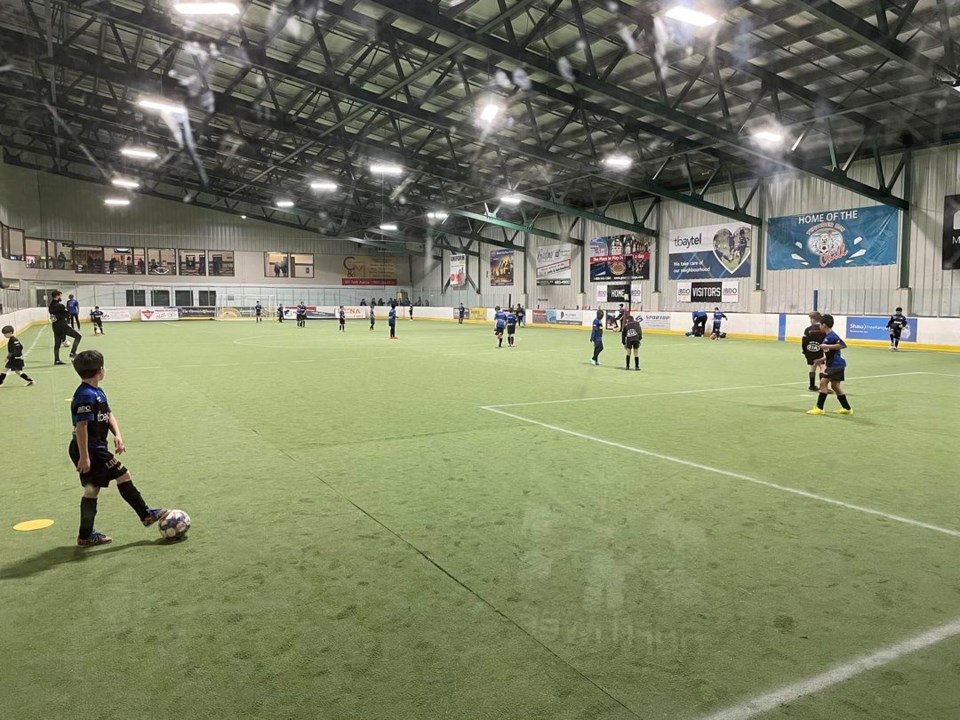THUNDER BAY — A local soccer group that championed a proposed indoor turf facility next to the Community Auditorium is questioning a city report that recommends against the proposal, and instead suggests sticking with an earlier concept at Chapples Park.
The report from city administration, released Wednesday, concludes building the facility next to the Auditorium would not deliver hoped-for savings.
Soccer Northwest Ontario had expressed confidence a hangar-style facility could be built for $20 million or less — compared to a price tag of well over $40 million at Chapples — when it first pitched its concept to city council late last year.
Council had greeted that possibility with enthusiasm, hoping it could resolve years of aborted attempts to find a workable indoor turf concept at a price tag council could accept.
Administration's report appears to pour cold water on those hopes, instead pegging total costs for the SNO concept between $33 million and $53 million, based on class C estimates prepared by a contractor.
Administration recommends continuing to pursue an option at Chapples instead, a location staff argue offers numerous benefits.
That recommendation will be discussed by city council on Monday.
Among the concerns administration’s report raises with the Community Auditorium-adjacent location are that it would displace a popular softball diamond and could cause traffic congestion when events are hosted concurrently at the turf facility and nearby venues like the auditorium and Port Arthur Stadium.
Administration also concluded the facility’s requirement for an additional 150 parking spaces could not be met on site, suggesting it could instead be provided off of nearby Winnipeg Avenue.
The report points to features present at Chapples, but not adjacent to the auditorium, like site seating, lighting, security, electric-ready parking spots, motor coach parking and turnaround, connectivity to active transportation and pedestrian paths, and landscaped bio-retention swales.
SNO president Michael Veneziale said he found those points questionable and unconvincing.
“At first glance, I find almost every one of their arguments for having it at the Chapples location, or not having the style of building we’ve proposed… I don’t find they hold a lot of validity and weight. I find it’s just more of a want to go back to the original plan at the original location.”
“I have a hard time understanding the parking and traffic arguments. If anybody’s gone through Chapples Park on a Tuesday or Thursday through the summer months, there are hundreds and hundreds of vehicles that have to park blocks away.”
“We know this is a cheaper location to build at,” he added. "There are bus routes that already go through, there’s a lot less ground work [needed].”
The report compares the SNO proposal, a version of the SNO proposal upgraded to meet the city’s facility design standards, and the larger design previously considered at Chapples.
Using class C estimates expected to be accurate within 15 to 20 per cent, consultant Hanscomb Ltd. estimated the SNO proposal would cost roughly $41 million, while the upgraded SNO proposal would cost $43.8 million.
An updated class A estimate for the Chapples design, meanwhile, considered accurate within five to ten per cent, estimated costs at roughly $51 million.
Veneziale said he had not been privy to the details of the city’s analysis, but expressed incredulity at the estimates.
“I completely disagree with the building costs for the facility,” he said. “I have spoken to a contractor, and that is not an accurate amount.”
He said SNO will ask council to approve an RFP process to seek proposals to build at the auditorium site, believing those would come in well below the city’s estimates.
“The only way to know for sure is to put it out to the [private] sector and say, ‘What can you build this for?’”
The SNO option was estimated to produce more than double the amount of greenhouse gas emissions and 10 per cent higher energy costs than the Chapples option, designed to LEED sustainability standards.
The report estimates that over a 40-year lifecycle, the Chapples building would be less expensive on a per square metre basis, though it is also larger than the SNO design.
Administration argues those numbers show the Chapples option provides “better value for money” than the SNO proposal, said general manager of community services Kelly Robertson.
“You did still find that SNO concept would be cheaper in terms of capital costs than what the city had been considering at Chapples, but administration's argument is when you look at the whole picture... it doesn't deliver the value, and it still makes more sense to stick with something closer to that Chapples concept,” she said.
“When you look at the Chapples option… the building has 23 per cent more usable space, offers more amenities, is located in a site that I would argue is a little bit less disruptive to current uses, allows for indoor-outdoor integration.”
Without a clearly cheaper build option, the report suggests the city look to a private sector partnership to reduce costs for a Chapples facility. Administration suggests reporting back by November with a proposed project financing plan required to issue an RFP.
Robertson said that would build on a call for expressions of interest the city previously issued for the project in 2021. The responses it received have never been made public.
“Based on the strength of the proposals we received, I’m hopeful that if we go to market again, that we would continue to receive some interest and that would be an opportunity... to contain cost to the city, bring equity to the project, and then help us figure out an operator for the facility as well,” said Robertson.
The city has set aside over $17 million in a capital fund intended to support an indoor turf facility, though council could decide to spend those dollars elsewhere.
